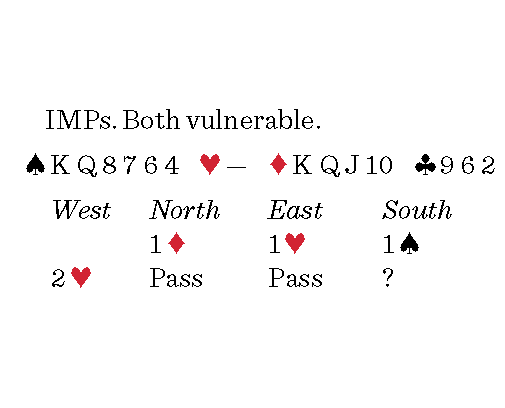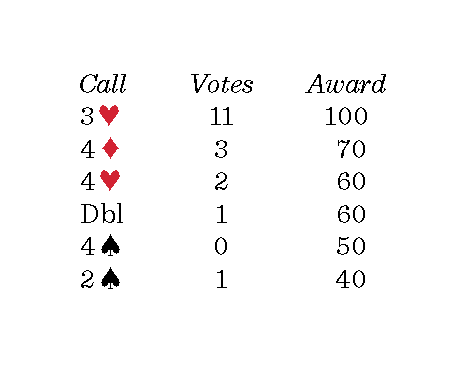
What’s your call?
| 2♠ | 2NT | |||
| 3♣ | 3♦ | 3♥ | 3♠ | 3NT |
| 4♣ | 4♦ | 4♥ | 4♠ | 4NT |
| 5♣ | 5♦ | 5♥ | 5♠ | 5NT |
| 6♣ | 6♦ | 6♥ | 6♠ | 6NT |
| 7♣ | 7♦ | 7♥ | 7♠ | 7NT |
| Dbl | Pass |
That’s your cue
Most of the panelists favor moving forward with a cuebid holding this pointed collection.
“3♥,” bids Cohen. “I have too few hearts and too many diamonds to double. It’s tempting to splinter to 4♥, but partner might not know if that is a self splinter in spades or a raise of diamonds.”
Meckstroth, too. “I think I need bet- ter defense to double. I would prefer to double, but I think that can be left in, so I’ll gamble we can make something and
cuebid 3♥.”
Stack calls 3♥ “forcing to game showing diamond support. But it doesn’t show this good of a spade suit. 3♥ has lots of flaws. With ♠J x, ♠x x or ♠A x and a heart stopper, partner will almost always bid 3NT. I will follow up with 4♦. 3♦ is only competitive and not even invitational, so it’s not a good bid at IMPs. 3♠ invitational is possible, but it doesn’t show the diamond fit.”
“I think I may try for slam if partner doesn’t bid 3NT,” indicates Hampson.
Robinson bids 3♥, game forcing, asking for two-card spade support. “I’ll support diamonds next if partner does not have two spades.”
“Even if 3♥ is not perfect,” say the Coopers, “we have to force to game. If partner bids 3♠ or 4♦, we’ll cuebid hearts. If he bids 3NT, we’ll probably pass, expecting partner to have good hearts.”
The Gordons create the force by bidding 3♥ and plan to pull partner’s 3NT to 4♦. “We had a discussion about the merit of an initial fit-showing jump shift with a two-card disparity like this. We concluded it wasn’t a good idea.”
Sanborn bids 3♥, also seeking a doubleton spade or any bid other than the anticipated 3NT. “I will remove 3NT to 4♦ and look for a third chance at spade support or to play 5♦.”
The Sutherlins explain their 3♥: “We play support doubles, so partner has denied three spades. Doubling 2♥ is risky. We might make 4♠ or 5♦.”
With their 3♥ cuebid, the Joyces are hoping to learn whether partner holds a doubleton spade.
Falk barrels in with 4♦. “I reject 3NT as a target game. Partner pretty much needs three aces and spades to break, and opposite three aces and spades breaking, we can make 4♠, 5♦ or 6♦. I reject 3♥ (the panel choice, I’m betting) because partner is a heavy favorite to bid 3NT, which I’ve already
rejected. If I bid 3♥ and then pull 3NT, I’m showing a stronger hand. I reject any number of spades because my spades aren’t good enough to bid 3♠ or 4♠ and my hand is too good for 2♠. I reject 3♦ as not enough and 5♦ as way too much. 4♦ should be what we can make opposite the worst collection of junk imaginable. It alerts partner that (1) I’m not good enough to force to game; (2) I am distributional; (3) I have at least five spades and at least four diamonds.”
Meyers favors a forcing 4♦. “I have to choose between forcing to game and inviting (in which case I would bid 3♠). Because my diamonds are so good, I am taking the high road. Partner has already denied three spades, but if I bid 4♦, she might bid 4♠ on ace or jack doubleton.”
Rigal believes 4♦ is forcing. “I don’t want to risk a double and find we are defending 2♥ doubled. The trouble with a jump to 3♠/4♠ is a 6–0 split. The presence or absence of a support double is almost irrelevant.”
Lawrence: “4♥, a splinter. Most likely it should be considered as support for diamonds. Partner may sign off in 4♠ if he has a doubleton. It would not be a cuebid.”
Colchamiro also elects to splinter. “4♥ leaves room for 4♠ from partner on ♠A x or ♠J x, or a high-level contract in diamonds. I would prefer to have a club card, but life is like that sometimes.”
Meanwhile, Walker’s out on a limb all by herself with a red card and a rosary. “I’m praying that the IMP conditions mean partner will be averse to passing unless he has really strong trumps.”

